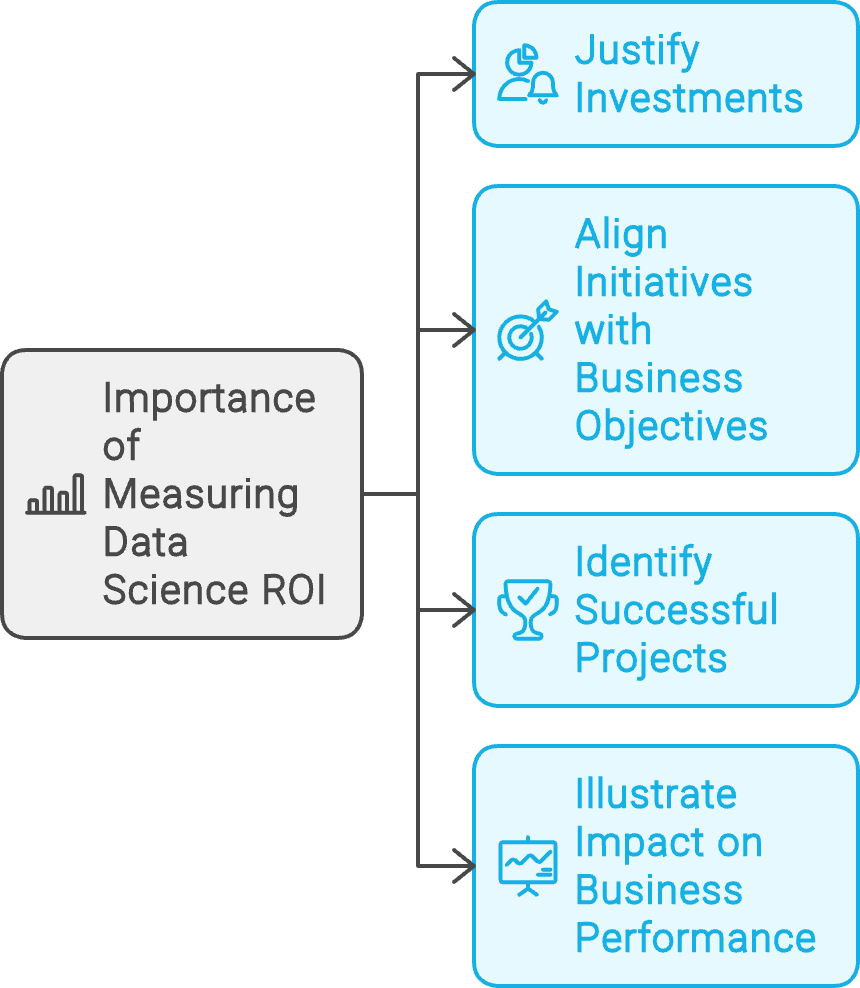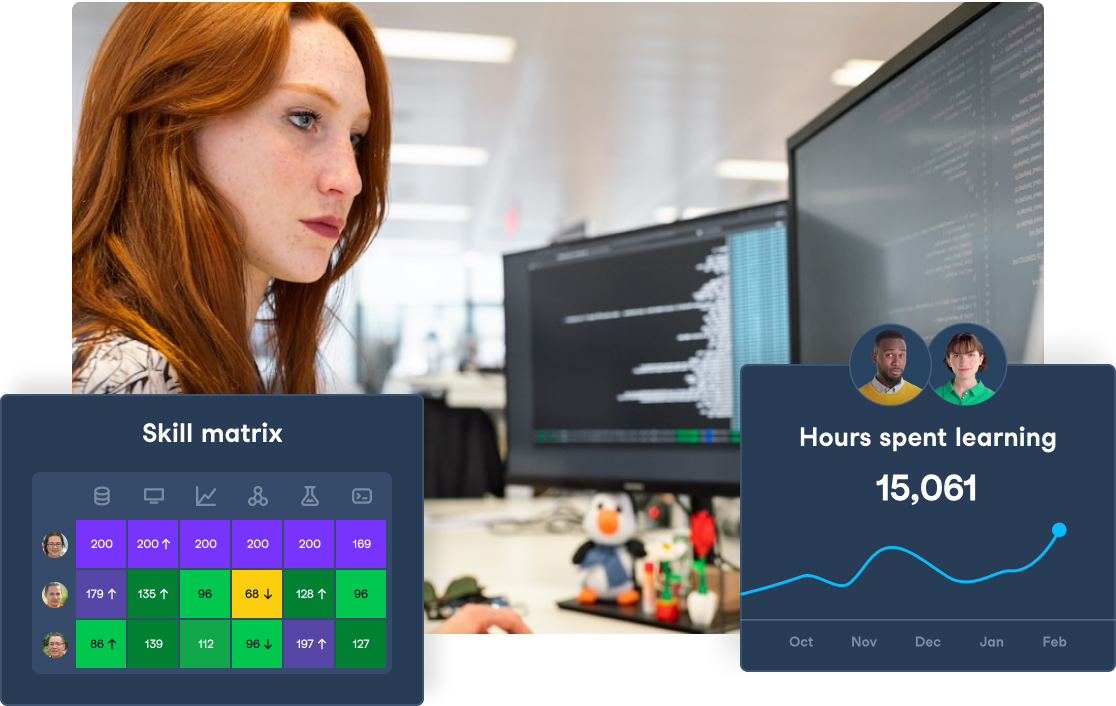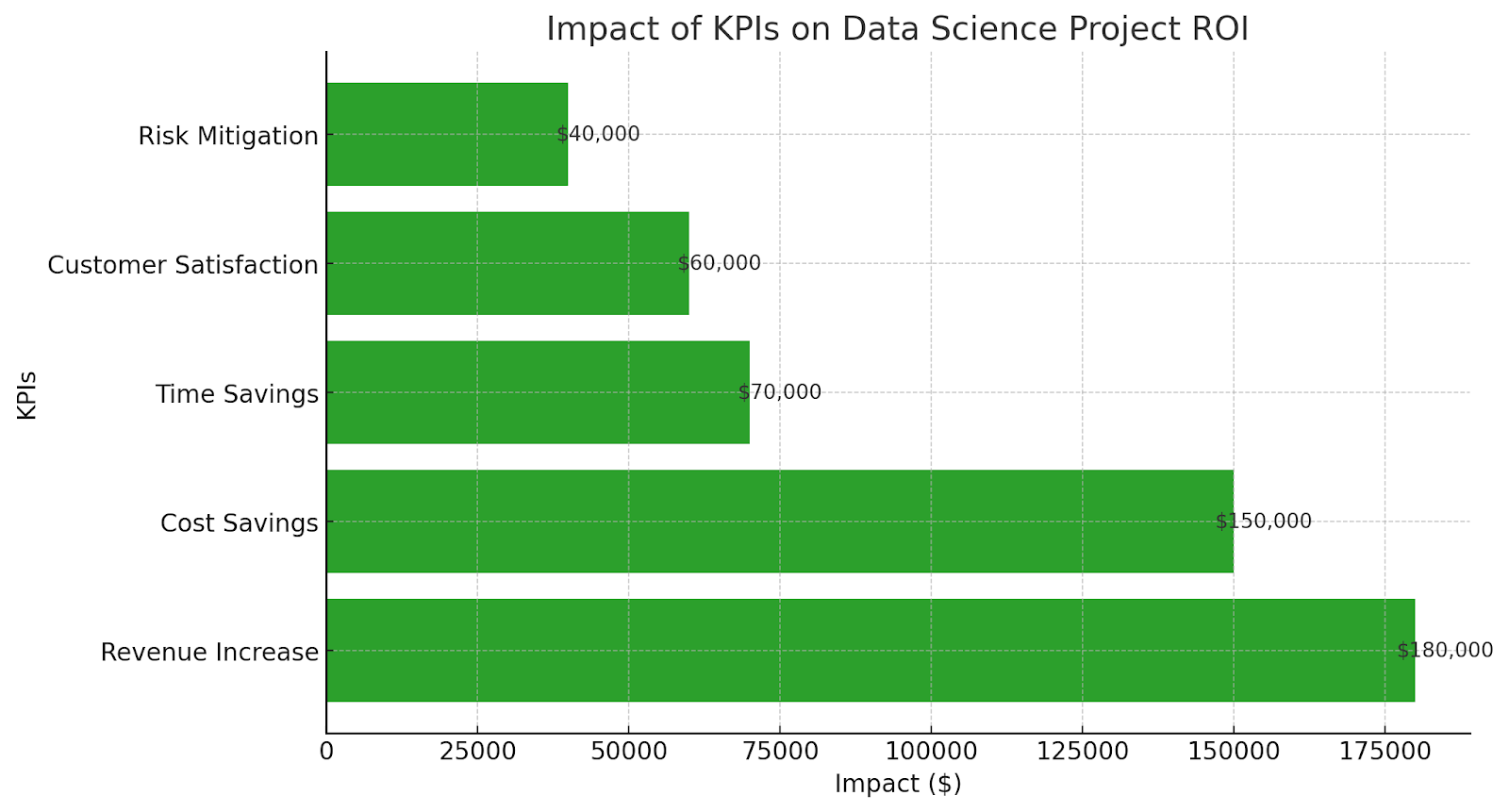Course
As businesses increasingly invest in data science initiatives, understanding the return on investment (ROI) metric becomes essential.
In this blog post, we explore how to measure, maximize, and communicate the ROI of data science projects, ensuring that these investments align with business goals and deliver tangible value.
Understanding the ROI of Data Science
In data science, the ROI represents the measurable business value or financial gain a data science project generates relative to the resources and investments required to execute and maintain it.
To fully grasp this concept, let's explore and apply the traditional ROI formula to data science.
Traditionally, ROI is calculated using the formula:
ROI = (Net Profit / Total Investment) x 100
Net profit is the revenue generated from an investment after deducting all associated costs. Conversely, total investment is the sum of all capital or resources put into the project.
When applied to data science, the ROI formula shifts slightly to capture the unique aspects of these initiatives better. The formula for data science ROI becomes:
Data Science ROI = (Net Benefit from Data Science Initiative / Cost of Data Science Initiative) x 100
Here’s a comparison of the traditional ROI approach and how it differs from calculating it for a data science project:
|
Traditional ROI |
Data science ROI |
|
|
Focus |
Primarily financial return |
Comprehensive business value, including intangible benefits |
|
Net benefit |
Net profit (revenue minus costs) |
Total measurable value (including cost savings, efficiencies, and risk mitigation) |
|
Costs considered |
Direct financial investments (capital, labor) |
Technology, infrastructure, talent, data, ongoing maintenance |
|
Challenges |
Capturing immediate, tangible benefits |
Quantifying intangible benefits, delayed ROI |
|
Examples of benefits |
Revenue growth, cost savings |
Operational efficiencies, improved decision-making, risk mitigation |
The net benefit from a data science initiative includes the total measurable value or financial return the project produces. This could manifest in various forms, such as cost savings, revenue increases, operational efficiencies, improved decision-making, risk mitigation, or other quantifiable benefits.
On the cost side, the investment in a data science initiative typically includes expenditures on technology and infrastructure, talent and personnel, data acquisition and preparation, model development and deployment, and ongoing maintenance and operations.

The ROI of a data science project depends on its total cost and net benefits.
By understanding and applying this formula, you can better evaluate the success of your data science projects and make more informed decisions about future investments.
Why Measuring Data Science ROI Is Important?
Organizations aiming to enhance the value and effectiveness of their data-driven capabilities find it important to assess the ROI of their data science projects. Here are the reasons why:
To justify investments in data science projects
Data science projects typically involve substantial initial investments in skilled personnel, cutting-edge tools, and necessary infrastructure.
Conducting a thorough ROI assessment offers a tangible and measurable approach to showcasing the anticipated business benefits and monetary gains from such undertakings, facilitating the acquisition of funding and resources.
Providing this rationale is relevant for securing approval from top management and maintaining ongoing backing for data science initiatives.
To align data science initiatives with business objectives
When organizations evaluate the ROI of their data science projects, they gain valuable insights into which projects align with their business objectives and priorities.
This synchronization guarantees that data science endeavors will focus on achieving significant outcomes and supporting the company’s overall prosperity.
By using ROI metrics, you can make well-informed choices regarding which data science applications to pursue and how to distribute their resources efficiently.
To identify successful projects and areas for improvement
Assessing the return on investment (ROI) of data science projects helps companies identify the most effective initiatives and the key drivers behind their achievements. This data can then be leveraged to duplicate and expand successful tactics and pinpoint opportunities for enhancement and streamlining.
Through ongoing monitoring and fine-tuning of your data science ROI, you can boost the impact and efficiency of your data-centric capabilities as they progress.
To illustrate how data science influences business performance
Measuring the ROI of data science projects offers a concrete and measurable method to demonstrate how data-informed decision-making positively affects the company's financial performance.
This helps establish reliability and trust in the importance of data science, nurture an environment that values data-based strategies, and ensure continued backing from company leaders and interested parties.
Businesses can validate additional funding, expand prosperous projects, and promote lasting development by showcasing the monetary advantages of using data science.

Measuring the ROI of a data science initiative has several benefits.
Advance Your Team's Data Science Skills
Unlock the full potential of data science with DataCamp for Business. Access comprehensive courses, projects, and centralized reporting for teams of 2 or more.

Metrics for Measuring Data Science ROI
By monitoring these key performance indicators (KPIs) closely, organizations can gain a comprehensive view of the returns on investment from their data science projects:
1. Cost efficiency
Cost efficiency measures the amount of money saved or the improved efficiency of operations due to data science initiatives. This metric is relevant for understanding how data-driven strategies reduce operational expenses.
For example:
- Organizations can significantly cut labor costs by streamlining manual tasks through automation.
- Data science can optimize routes and schedules in supply chain and logistics, reducing waste and lowering transportation expenses.
- Additionally, predictive maintenance—powered by data models—can extend the lifespan of equipment and reduce the frequency of costly repairs or replacements, thereby lowering overall maintenance expenses.
2. Revenue growth
Revenue growth tracks the increase in sales, the discovery of new revenue sources, or overall business expansion caused by data science applications. This metric is essential for assessing how data initiatives directly contribute to top-line growth.
For example:
- Data science can create predictive models identifying high-value customer segments, enabling more targeted and effective marketing efforts.
- By leveraging data insights, businesses can launch new products or services that better meet customer needs, thus driving additional revenue.
- Furthermore, improved demand forecasting through data analysis allows for more intelligent pricing strategies and optimized inventory management, boosting sales and reducing costs associated with overstocking or stockouts.
3. Time efficiency
Time efficiency measures the reduction in time required to complete tasks or processes, resulting in higher productivity and operational efficiency. This metric is important for understanding how data science initiatives streamline operations.
For example:
- Automating data processing and analysis accelerates decision-making, allowing businesses to respond more quickly to market changes or opportunities.
- Implementing chatbots or virtual assistants can enhance operational efficiency and customer interactions by handling routine inquiries and tasks.
- Additionally, automating repetitive or time-consuming tasks frees employees to focus on more strategic activities, increasing overall productivity.
4. Enhancing customer satisfaction
Enhancing customer satisfaction measures improvements in customer experience, which can lead to greater loyalty, retention, and positive referrals. This metric helps evaluate the long-term impact of data science on customer relationships.
For example:
- Predictive analytics can personalize product recommendations, creating a more tailored and satisfying customer experience.
- Data-driven insights, particularly natural language processing (NLP), can enhance customer service and support effectiveness by helping us better understand and address customer inquiries.
- Furthermore, businesses can tailor pricing and promotional strategies based on customer behavior and preferences, leading to more relevant and appealing offers.
5. Mitigating risks
Mitigating risks involves reducing potential risks and losses, which can significantly impact an organization's financial performance. This metric is vital for assessing how data science contributes to the stability and security of the business.
For example:
- Early warning systems powered by data models can help organizations identify and prevent fraud or cybersecurity threats before they escalate.
- Predictive models can also anticipate supply chain disruptions or operational risks, allowing businesses to address these issues proactively.
- Moreover, data-driven insights can improve compliance with regulations by automating procedures and ensuring that the organization adheres to legal requirements.

A horizontal bar chart showing the impact of various Key Performance Indicators (KPIs) on the data science project's ROI, with hypothetical values.
In the above image, each bar represents the monetary impact of a specific KPI, helping to illustrate how different aspects of the project contribute to its overall success. This understanding allows organizations to make better decisions, optimize resource allocations, and foster sustainable growth.
Steps To Calculate Data Science ROI
Calculating the ROI of data science projects involves several steps. By following this structured approach, you can accurately assess the value generated by your data science initiatives.
1. Clarify the goals and aims of the project
Begin by establishing specific, measurable goals for the data science project. These goals should align with broader business objectives to ensure the project contributes meaningfully to the organization’s overall strategy.
It's essential to identify KPIs that will be used to track progress and measure the achievement of these goals. Precise alignment between the project’s objectives and the company’s strategic priorities will provide a solid foundation for evaluating ROI.
2. Calculate the expenses linked to the project
To understand the actual cost of a data science project, it's important to account for all related expenses. These typically include:
- Staff costs: Consider the salaries and benefits for all team members, including data scientists, analysts, technicians, project managers, and IT support staff.
- Software and applications: Factor in the costs of essential software tools, such as analytics platforms, AI frameworks, and presentation software for reporting and visualization.
- Technical infrastructure: Include expenses related to cloud computing services, data storage solutions, and hardware upgrades. Additionally, consider the costs of acquiring and organizing the data needed for the project.
- Training and skill development: Account for any training and professional development investments to equip team members with the skills required for the project.
3. Evaluate the project's gains
Next, assess both the tangible and intangible benefits of the project:
- Tangible financial benefits: Calculate the direct financial gains, such as increased revenue, cost reductions, and time savings. Time savings should be quantified by converting the hours saved into monetary value based on employee salaries or operational efficiencies.
- Intangible benefits: Consider the less quantifiable but equally important benefits such as improved customer satisfaction, enhanced brand reputation, and reduced risks. These factors contribute to the project's overall value, even if they are harder to express in dollar terms.
Gathering data on the identified KPIs before and after the project’s implementation is essential. This allows for a comparison that highlights the project's impact.
4. Calculate the ROI
After identifying the project’s costs and evaluating its gains, the final step is calculating the ROI. This step involves quantifying the overall financial performance of the data science project in terms of its costs.
The ROI formula is:
Data Science ROI = (Net Benefit from Data Science Project / Total Cost of Data Science Project) x 100
Where:
- The net benefit from the data science project is the total gains (both tangible and intangible) minus any ongoing operational costs. This includes revenue increases, cost savings, time efficiencies converted into monetary terms, and other measurable benefits.
- The total cost of the data science project is the sum of all expenses incurred, including staff costs, software and infrastructure investments, data acquisition, and training expenses.
Steps to calculate:
- Determine the net benefit: Subtract the ongoing operational costs from the total gains (both financial and intangible) identified in step 3.
- Sum up the total costs: Add up all the costs associated with the project as detailed in step 2.
- Apply the ROI formula: Plug the net benefit and total cost figures into the formula to calculate the ROI percentage.
Example calculation:
Let’s say a data science project resulted in total measurable benefits of $500,000, as seen in the example offered in the previous section, and the total project cost was $200,000. After accounting for $50,000 in ongoing operational costs, the net benefit would be $450,000.
So, the ROI would be:
ROI = (450,000 / 200,000) * 100 = 225%
This result indicates that for every dollar spent on the project, the company gained $2.25 in return.
Interpret the results:
A positive ROI indicates that the project has delivered more value than its cost, justifying the investment. A higher ROI percentage means greater returns relative to the costs. Conversely, a negative ROI suggests the project's costs outweigh its benefits, signaling a need to reassess its approach or implementation.
5. Understand and share results
Evaluate the ROI against industry standards and company goals. Prepare a clear report detailing the ROI calculation, methodology, and critical insights. Communicate the results to stakeholders, highlighting the project's impact on business objectives.
6. Monitor
Regularly review the project's ROI to ensure it meets expectations. Identify areas for improvement and apply these lessons to enhance future data science projects, ensuring ongoing efficiency and value.

Successfully calculating the ROI involves several important steps.
Challenges in Measuring Data Science ROI
Let's discuss the typical hurdles companies encounter when trying to gauge the return on investment for data science initiatives and offer real-world solutions and tactics to address them.
Difficulty in quantifying intangible benefits
In numerous data science projects, the outcomes often include nontangible advantages such as better decision-making and enriched customer interactions, which can be challenging to measure financially.
Even though significant, the advantages are not straightforward to incorporate into standard ROI evaluations.
- Potential solutions:
- Proxy metrics: Find specific ways to measure intangible advantages effectively. For instance, monitor the decrease in decision-making time or the rise in favorable results to gauge enhanced decision-making.
- Qualitative assessments: To gather qualitative enhancements, conduct surveys, or organize discussions with involved parties. Employ techniques such as the Net Promoter Score (NPS) to measure enhancements in customer contentment.
- Benchmarking: It is important to assess performance metrics before and after launching data science initiatives. To evaluate progress effectively, consider industry standards as a reference point for improvement.
Long project timelines and delayed results
Data science projects frequently undergo extended development periods and might not yield immediate outcomes. This postponement can create challenges in directly linking the project's advantages and retaining stakeholder support.
- Potential solutions:
- Milestone-based evaluation: Divide the project into more manageable and trackable goals. Establish and monitor key performance indicators for each phase of the project.
- Phased implementation: Let's break down the project into stages, ensuring that each stage brings tangible benefits. By evaluating the completed stages sooner, we can calculate the return on investment.
- Predictive ROI models: Create models that forecast future returns on investment using initial cues and past information from comparable projects. Incorporate new data regularly to keep these models current.
- Long-term value tracking: Establish mechanisms to monitor sustained value generation, even after the formal conclusion of the project. Carry out regular assessments post-implementation to capture any delayed advantages.
Ensuring data privacy and compliance
Strict data privacy laws may restrict data access or raise project expenses. Failing to comply could negate potential advantages and affect ROI assessments.
- Potential solutions:
- Privacy-preserving techniques: Apply data anonymization, encryption, and differential privacy methods. Whenever feasible, opt for synthetic data for development and testing purposes.
- Compliance by design: Integrate compliance requirements into the project planning phase and factor compliance-related costs when calculating ROI.
- Data governance framework: Create a robust data management structure that considers the data's usefulness and the need for privacy and adherence to regulations. Clearly outline policies for accessing and using data.
- Regular audits: Review privacy and compliance measures regularly. Factor in the expenses for these assessments when calculating return on investment and assessing the benefits of reducing risks.
- Stakeholder education: Inform stakeholders about the significance of maintaining data privacy and following regulations. This approach could lead to garnering backing for essential yet expensive privacy protocols.
Best Practices for Maximizing Data Science ROI
Data science ROI will help companies make better decisions and enhance the effectiveness of their investments in data science. Here are some best practices to maximize it:
- Kick things off by tackling the easy tasks first: Start with projects that can show results fast and prove their value quickly. Utilize these initial achievements to gain traction and garner backing for more challenging endeavors.
- Make sure your data is top-notch: Put your resources into refining, organizing, and overseeing your data—high-quality data results in better models and more trustworthy insights.
- Embrace agile practices: Implement step-by-step methods to add value gradually. Frequently review project goals and adjust course if needed.
- Invest in tools and infrastructure: Opt for cloud-based options to save on costs and quickly scale up when needed.
- Form diverse teams: Bring together data experts, industry professionals, and business partners to work as one. Encourage teamwork between data specialists and IT units.
- Focus on deploying and operationalizing models: Incorporate models into business operations and decision-making processes. Establish strong monitoring and upkeep procedures for implemented models.
- Reuse and repurpose: Seek chances to implement proven models or methods in various business sectors or scenarios. Develop reusable elements and collections to speed up upcoming projects.
The Importance of Data Literacy
Data literacy—the ability to understand, interpret, and effectively use data—is important in maximizing the ROI of data science projects. When teams across an organization possess strong data literacy skills, they can better comprehend the insights generated by data science initiatives, leading to more informed decision-making.
Improved data literacy ensures that stakeholders can accurately assess the value of data-driven strategies, align them with business goals, and identify opportunities for optimization. This shared understanding fosters collaboration between data scientists and business units, enabling more targeted and effective resource use.
Moreover, a data-literate workforce is more likely to trust and act on data insights, accelerating the implementation of data-driven solutions. This trust enhances the impact of data science projects, driving higher ROI by ensuring that the insights are applied directly to the organization.
Conclusion
In this article, we discussed strategies for measuring, maximizing, and communicating the ROI of data science projects in an organization and reviewed the significance of promoting data literacy in the workplace.If you’re interested in learning more, consider checking Data Camp's course on foundational data skills for business leaders to learn more about the benefits of data science for companies.
Empower Your Team with Data Literacy
Enhance your team's data literacy and decision-making capabilities with DataCamp for Business. Access diverse courses, hands-on projects, and centralized insights for teams of 2 or more.

FAQs
Which factors are often overlooked but can impact the ROI of data science efforts?
Elements like data quality, collaborative teamwork, managing change effectively, and ongoing model upkeep can substantially impact the actual returns achieved through data science endeavors.
How can I convince upper management to invest in data science if the ROI isn't immediately clear?
To gain buy-in from upper management, start with small, quick-win projects that can demonstrate value early on. Use these successes to build a case for larger investments. Additionally, emphasize the long-term benefits of data science, such as improved decision-making and risk mitigation, even if they’re harder to quantify in the short term.
What tools can I use to track and measure the ROI of my data science projects?
There are several tools available for tracking and measuring ROI, such as project management software like Jira or Asana for tracking progress and costs, and analytics platforms like Tableau, Power BI, or Google Data Studio to visualize and report on key metrics. For more complex ROI calculations, consider using financial modeling tools like Excel or more specialized ROI calculators.
How should I handle situations where the data science project's outcomes differ significantly from initial ROI predictions?
When outcomes differ from predictions, conduct a thorough post-mortem analysis to understand what went wrong or right. Identify any assumptions that were incorrect and adjust your models and future predictions accordingly. This analysis will provide valuable insights for refining your approach and improving the accuracy of future ROI estimates.
Can qualitative benefits of data science be integrated into ROI calculations?
Yes, qualitative benefits can be integrated into ROI calculations through the use of proxy metrics or by assigning a monetary value to qualitative outcomes. For instance, improved customer satisfaction might be translated into increased customer retention rates, which can then be linked to revenue. Qualitative assessments and surveys can also provide supporting data to justify these valuations.
How can I ensure that my data science team stays aligned with business objectives throughout the project?
Regular communication between the data science team and business stakeholders is key. Establish clear KPIs that align with business goals and hold periodic check-ins to ensure the project remains on track. Additionally, involve business stakeholders in the project’s early stages, particularly in goal-setting and defining success criteria, to ensure alignment from the start.

Vinita Silaparasetty is the Chief Data Scientist of Trendwise Analytics, an author, and speaker. She holds an MSc. in Data Science from Newcastle University in the U.K. She specializes in Python, R and Julia for Generative AI, Machine Learning and Deep Learning. Her expertise includes using Tensorflow and Keras for neural network model building.



